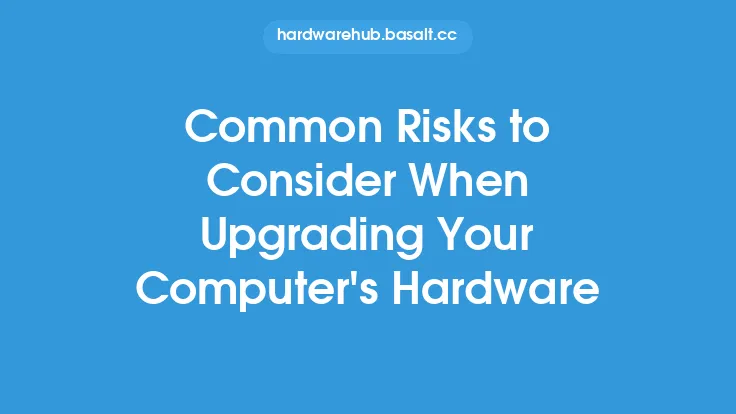Upgrading your computer can be a great way to breathe new life into an old machine, improve performance, and enhance overall user experience. However, it's essential to be aware of the potential security risks associated with upgrading your computer. These risks can arise from various sources, including the introduction of new hardware or software, changes to system configurations, and the potential for data breaches or unauthorized access.
Introduction to Upgrade Risks
When upgrading your computer, you're essentially modifying its internal components or adding new ones. This process can sometimes introduce security vulnerabilities, especially if the new components or software are not properly configured or are incompatible with the existing system. For instance, installing a new network card or updating the operating system can potentially open up new avenues for hackers to exploit. It's crucial to understand these risks and take necessary precautions to mitigate them.
Firmware and Driver Updates
Firmware and driver updates are common during computer upgrades. While these updates are designed to improve performance and compatibility, they can also introduce security risks if not properly validated. Malicious firmware or drivers can compromise the security of your system, allowing unauthorized access or data theft. It's essential to ensure that any firmware or driver updates come from trusted sources and are properly installed and configured.
BIOS and UEFI Updates
The Basic Input/Output System (BIOS) or Unified Extensible Firmware Interface (UEFI) is the firmware that controls the boot process and hardware initialization. Updating the BIOS or UEFI can sometimes introduce security risks, especially if the update is not properly validated or if the new firmware contains vulnerabilities. A compromised BIOS or UEFI can allow attackers to gain low-level access to the system, potentially leading to data breaches or system compromise.
Operating System Updates
Operating system updates are a common aspect of computer upgrades. While these updates often include security patches and improvements, they can also introduce new security risks if not properly configured. For example, a new operating system may include new features or services that are enabled by default, potentially creating new attack surfaces. It's essential to carefully review and configure the operating system settings after an update to ensure that security is not compromised.
Hardware-Based Security Risks
Certain hardware upgrades can also introduce security risks. For example, adding a new network interface card (NIC) or a wireless adapter can potentially create new entry points for attackers. Similarly, installing a new storage device, such as a solid-state drive (SSD), can introduce risks if the device is not properly encrypted or if the data is not properly wiped before disposal.
Supply Chain Risks
The supply chain for computer hardware and software can be complex and global. This complexity can sometimes introduce security risks, especially if the components or software come from untrusted sources. For example, a malicious actor may compromise a hardware component or software package during the manufacturing or distribution process, potentially allowing them to gain access to the system or steal sensitive data.
Best Practices for Mitigating Upgrade Risks
To mitigate the potential security risks associated with upgrading your computer, it's essential to follow best practices. These include:
- Validating the authenticity and integrity of any new hardware or software components
- Ensuring that all updates come from trusted sources
- Carefully reviewing and configuring system settings after an update
- Implementing robust security measures, such as encryption and access controls
- Regularly monitoring the system for potential security breaches or vulnerabilities
- Disposing of old components and data securely
Conclusion
Upgrading your computer can be a great way to improve performance and enhance user experience. However, it's essential to be aware of the potential security risks associated with the upgrade process. By understanding these risks and following best practices, you can help mitigate them and ensure the security and integrity of your system. Remember, security is an ongoing process that requires constant vigilance and attention to detail. Stay informed, stay vigilant, and always prioritize security when upgrading your computer.





